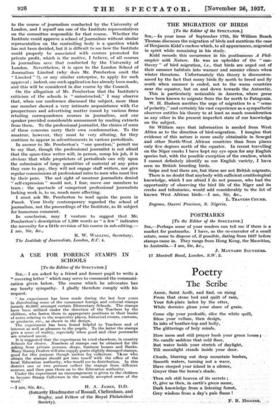THE MIGRATION OF BIRDS
[To the Editor of the SPECTATOR.] Sht,—In your issue of September 17th, Sir William Beach Thomas discusses the migration of birds and mentions the case of Benjamin Kidd's cuckoo which, to all appearances, migrated in spirit while remaining in his study.
Kidd records this occurrence in his posthumous A Phil- osopher with Nature. He was an upholder of the " sun- theory " of bird migration, i.e., that birds are urged out of their summer habitats into warmer and sunnier climes when winter threatens. Unfortunately this theory is discounten- anced by the fact that many birds.fly north to breed and fly south when summer is ended, not to the warm countries near the equator, but on and down towards the Antarctic.
This is particularly noticeable in America, where geese have been known to migrate from the far north to Patagonia.
W. H. Hudson ascribes the urge of migration to a " sense of polarity," and certainly his vast experience as a sympathetic observer entitles his theory to at least as much consideration as any other in the present imperfect state of our knowledge on the subject.
Sir William says that information is needed from West Africa as to the direction of bird-migration. I imagine that evidence of this nature is more easily obtainable in Senegal and other North-West African countries than from places only five degrees north of the equator. In recent travelling on the Niger creeks I have kept my eye open for any English species but, with the possible exception of the swallow, which I cannot definitely identify as our F.nglish variety, I have seen no British breeding birds.
Snipe and teal there are, but these are not British migrants.
There is no doubt that anybody with sufficient ornithological knowledge, which I am afraid I do not possess, who had the opportunity of observing the bird life of the Niger and its creeks and tributaries, would add considerably to the list of known West African birds.—I am, Sir, &c.,






















































 Previous page
Previous page